Pragmatic functions of self-repair in conversations from Vietnamese television films
Self-repair in conversations is necessary for the speakers to make clearer what they are
speaking to the listeners. Simultaneously, self-repair helps talks be kept on and makes conversations
smoother and more effective. There are many reasons why speakers in conversations want to repair their
trouble source. Based on the theory of self-repair from Schegloff, Jefferson & Sacks, data from
conversations in Vietnamese television films with everyday familiar topics which have been issued from
the 1980s up to now and based on the theory of the pragmatics of illocutionary forces, the paper presents
and analyzes the pragmatic functions of self-repair in conversations in Vietnamese television films so
that learners of Vietnamese can have more effective conversations in their daily life.
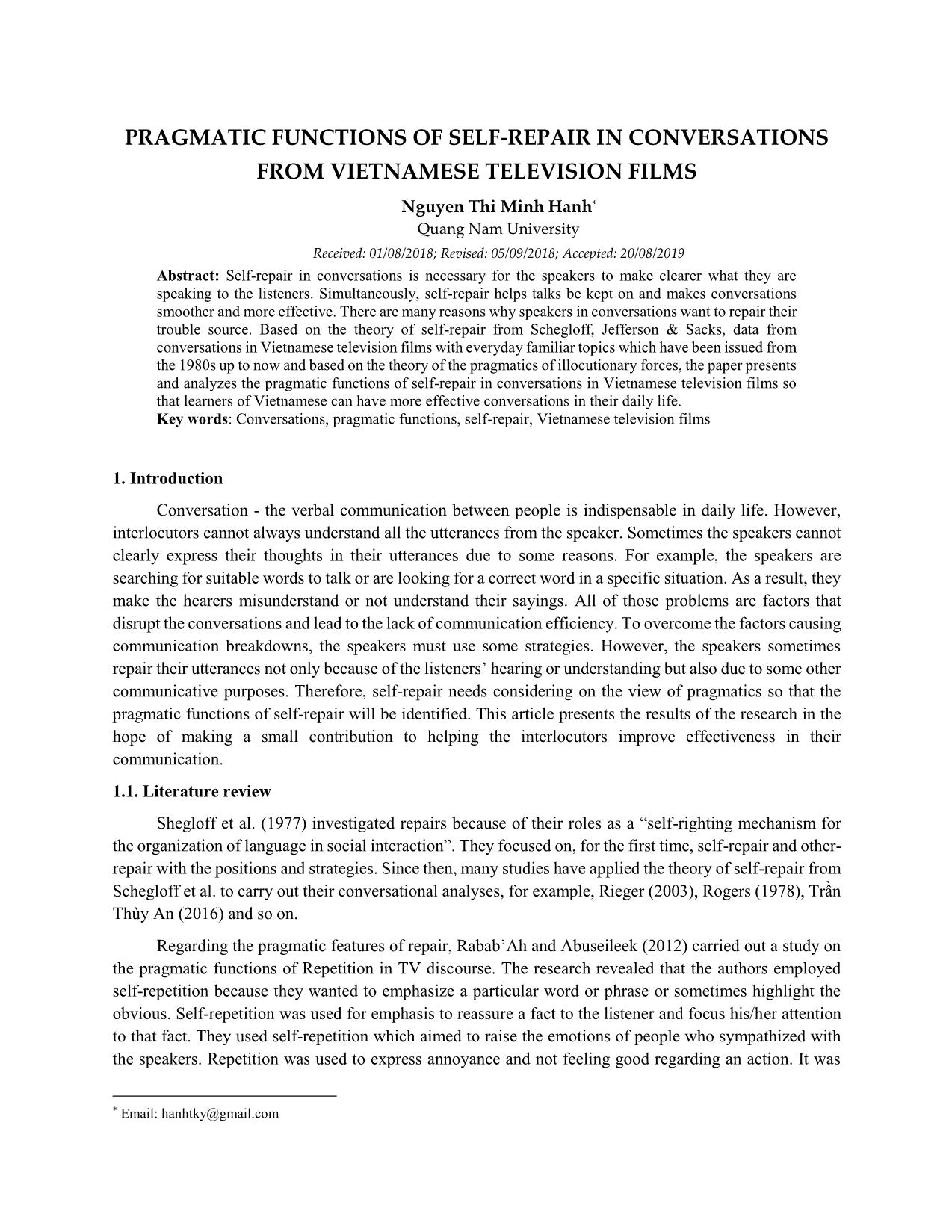
Trang 1
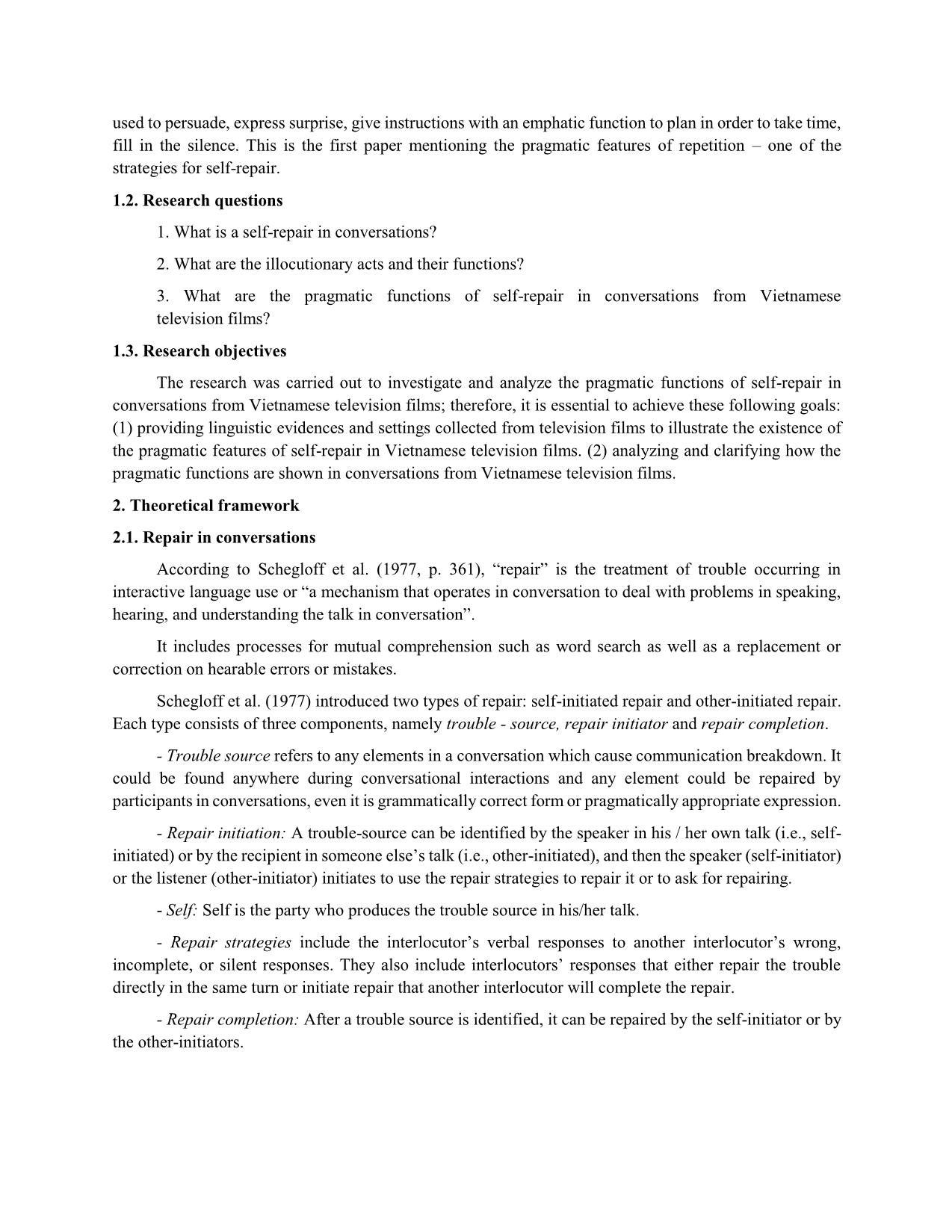
Trang 2
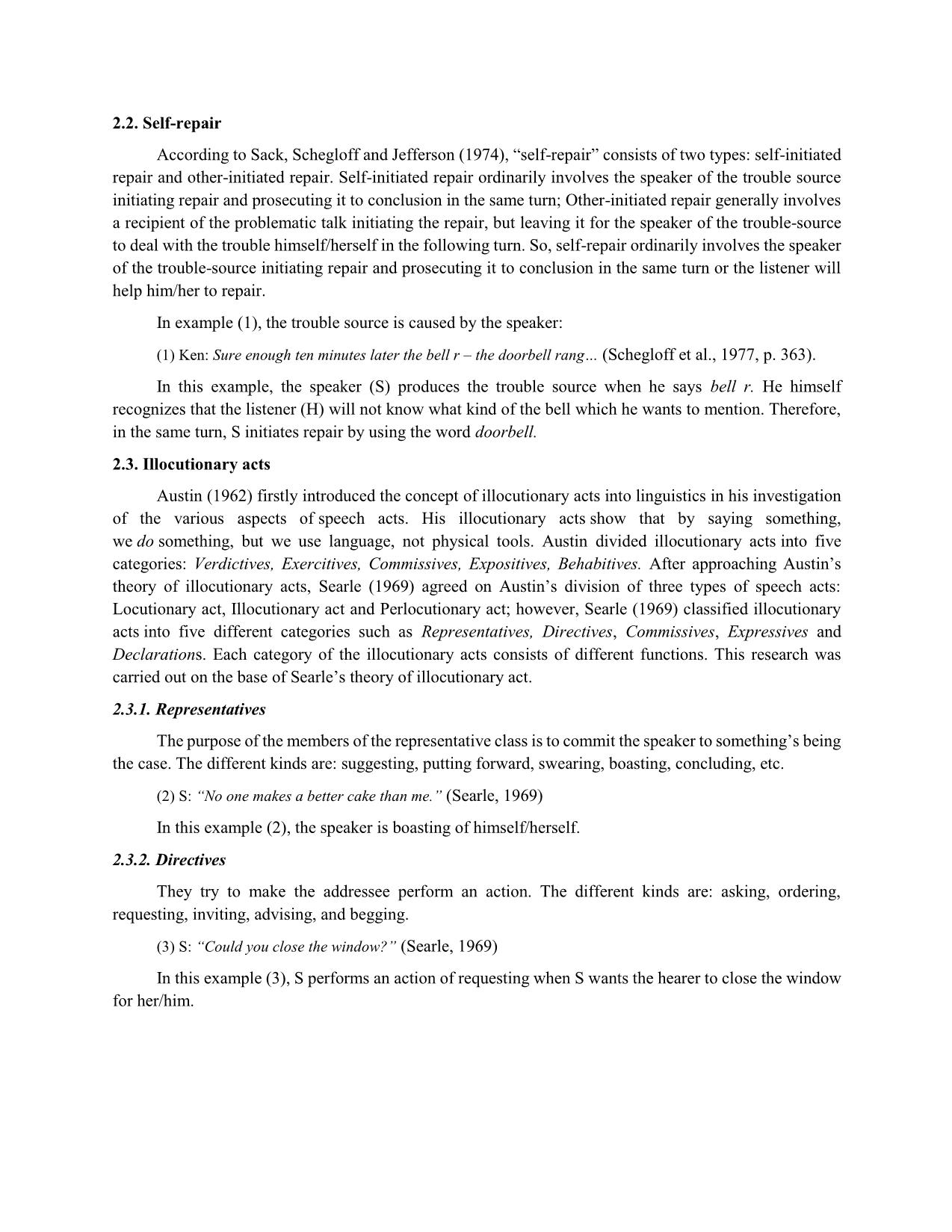
Trang 3
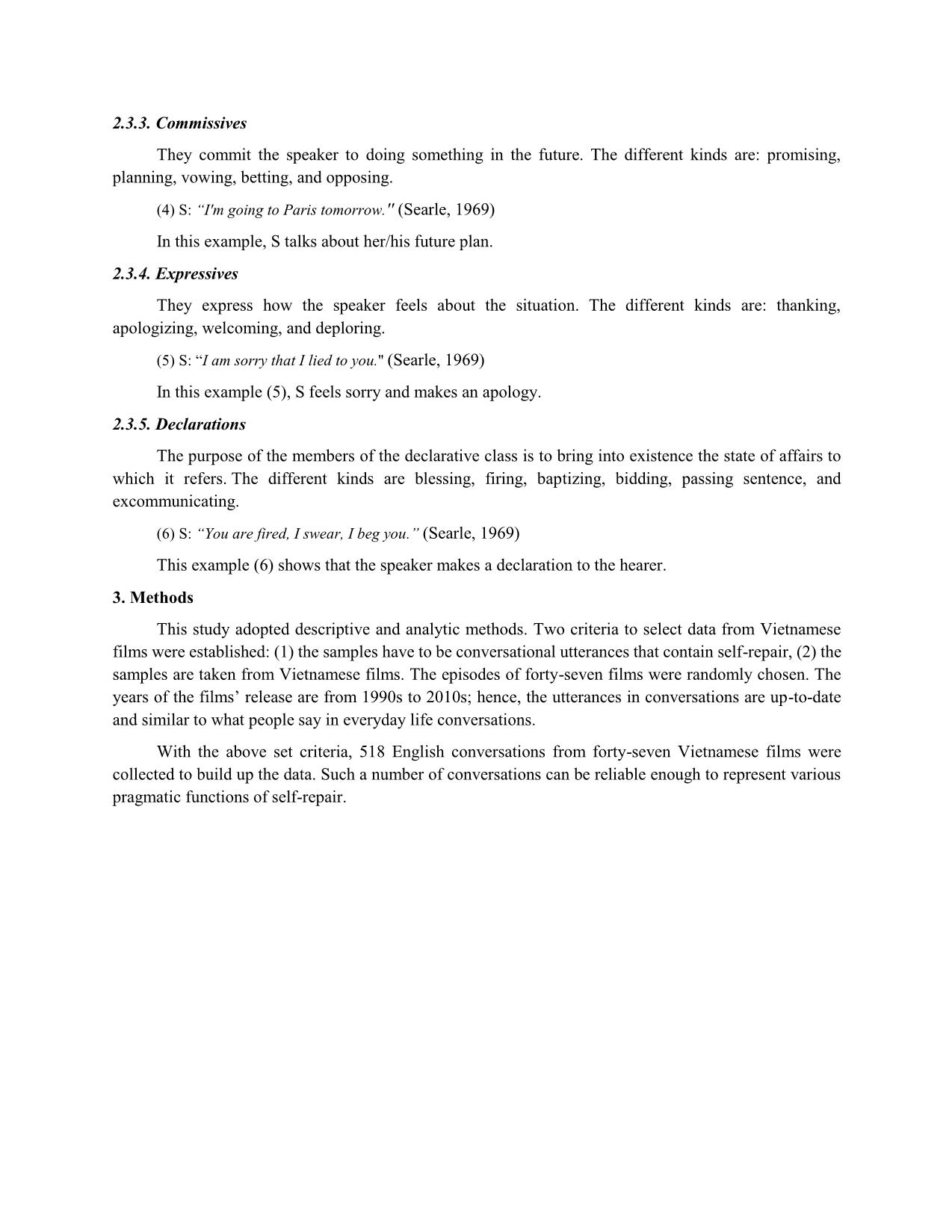
Trang 4
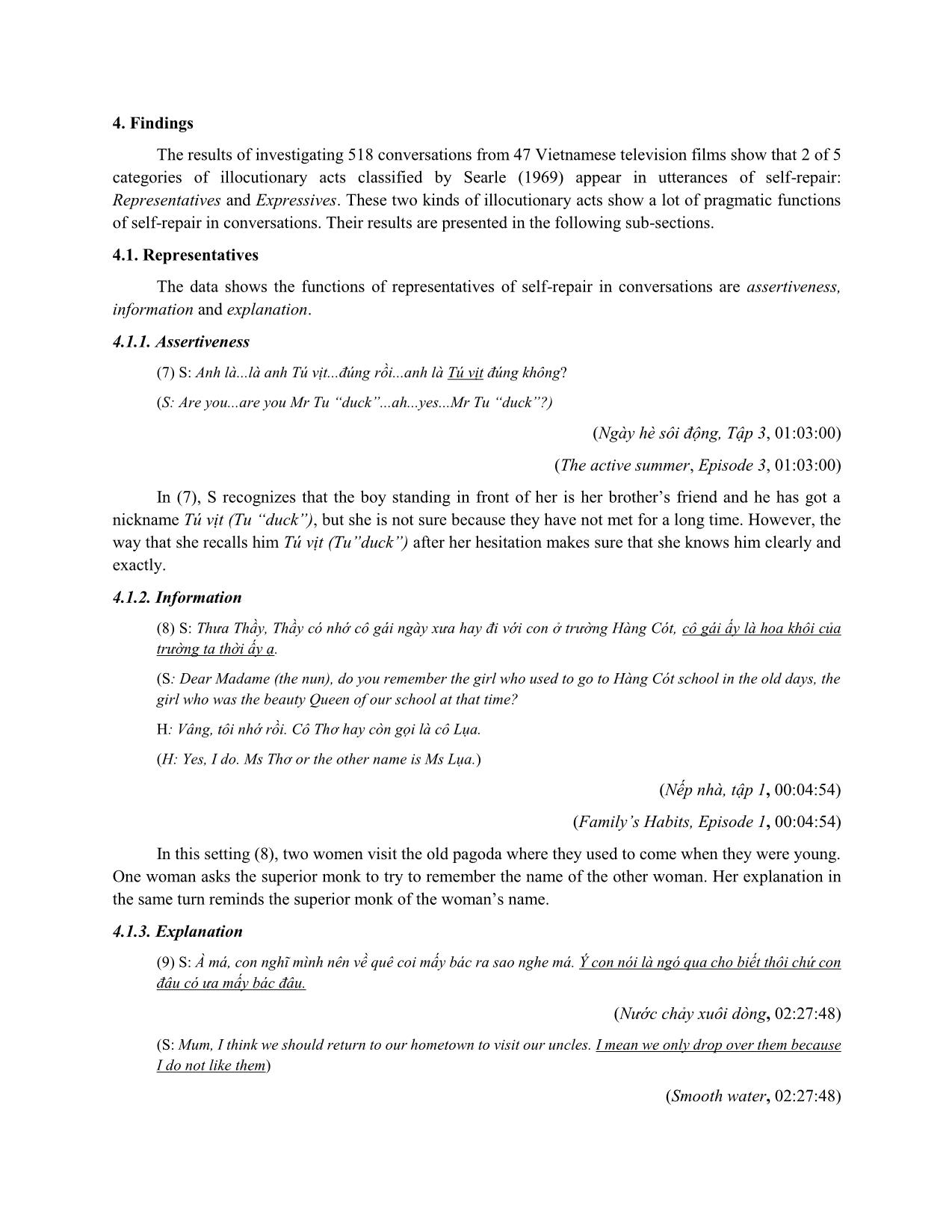
Trang 5
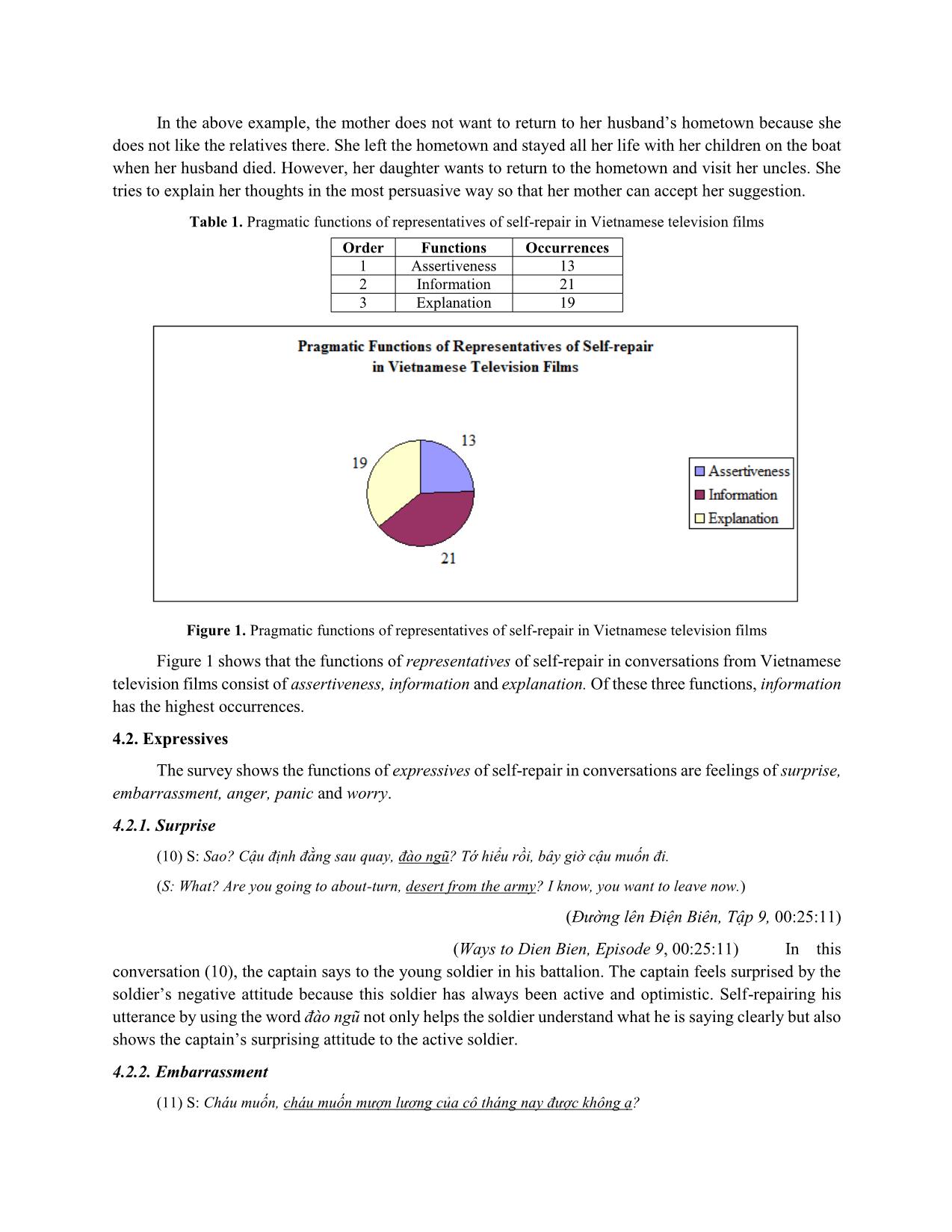
Trang 6
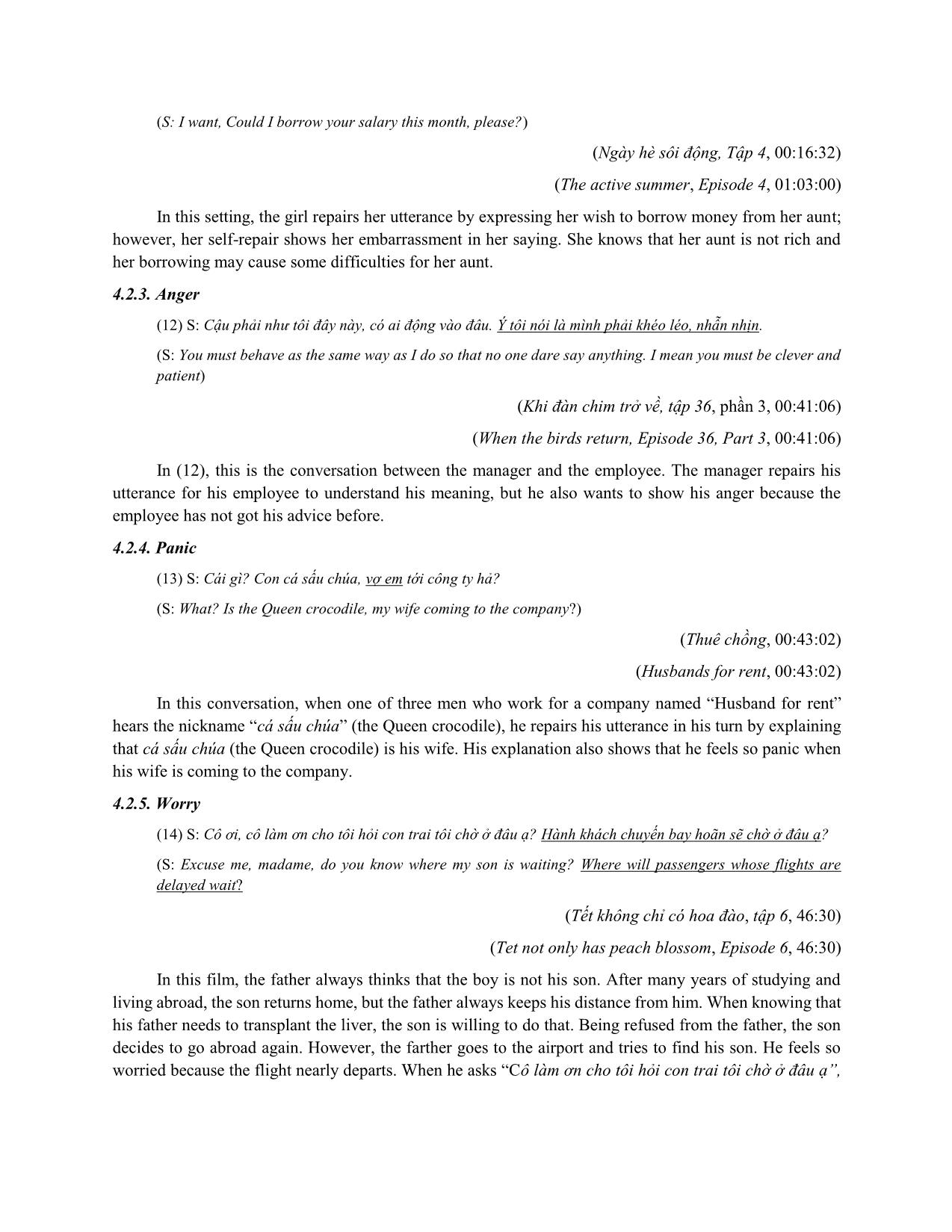
Trang 7
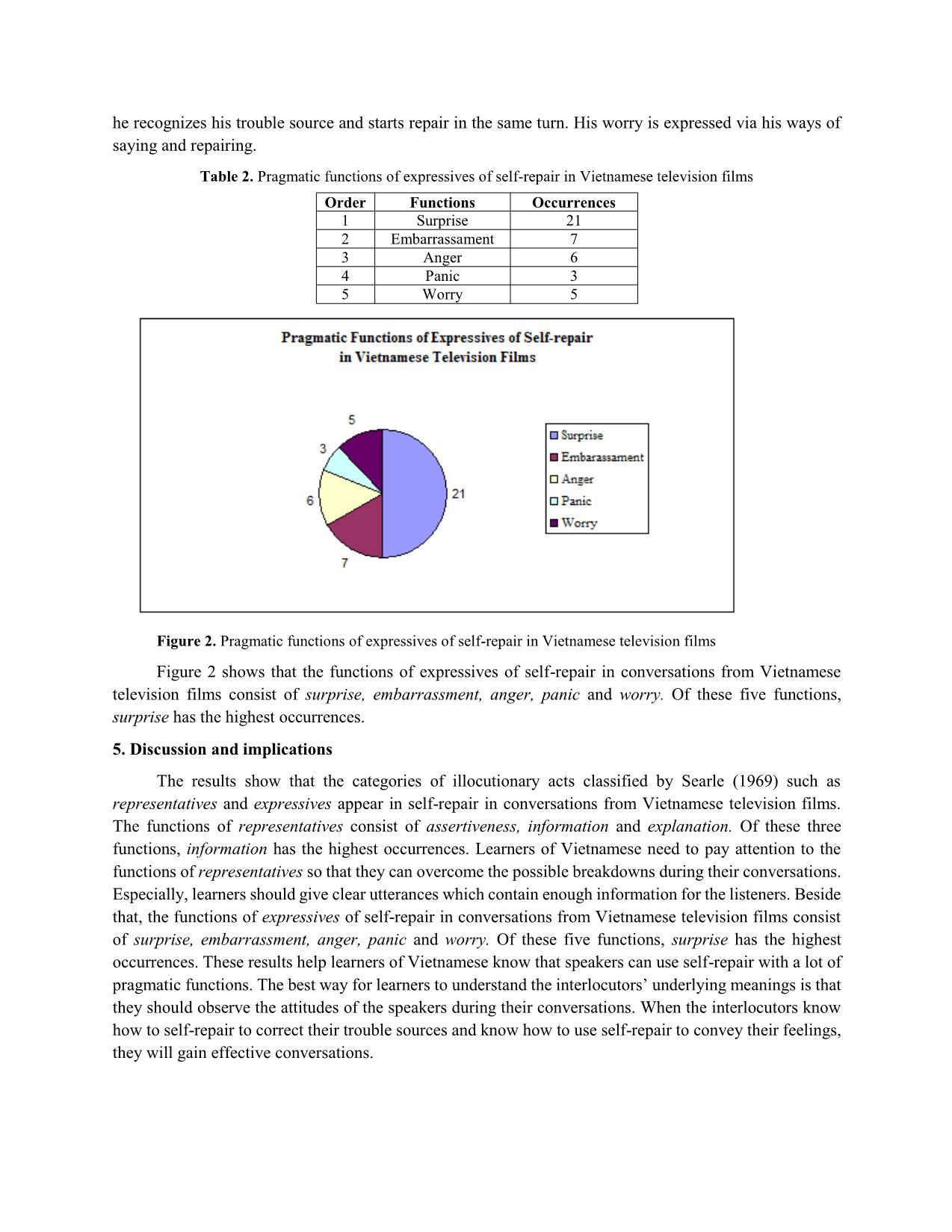
Trang 8
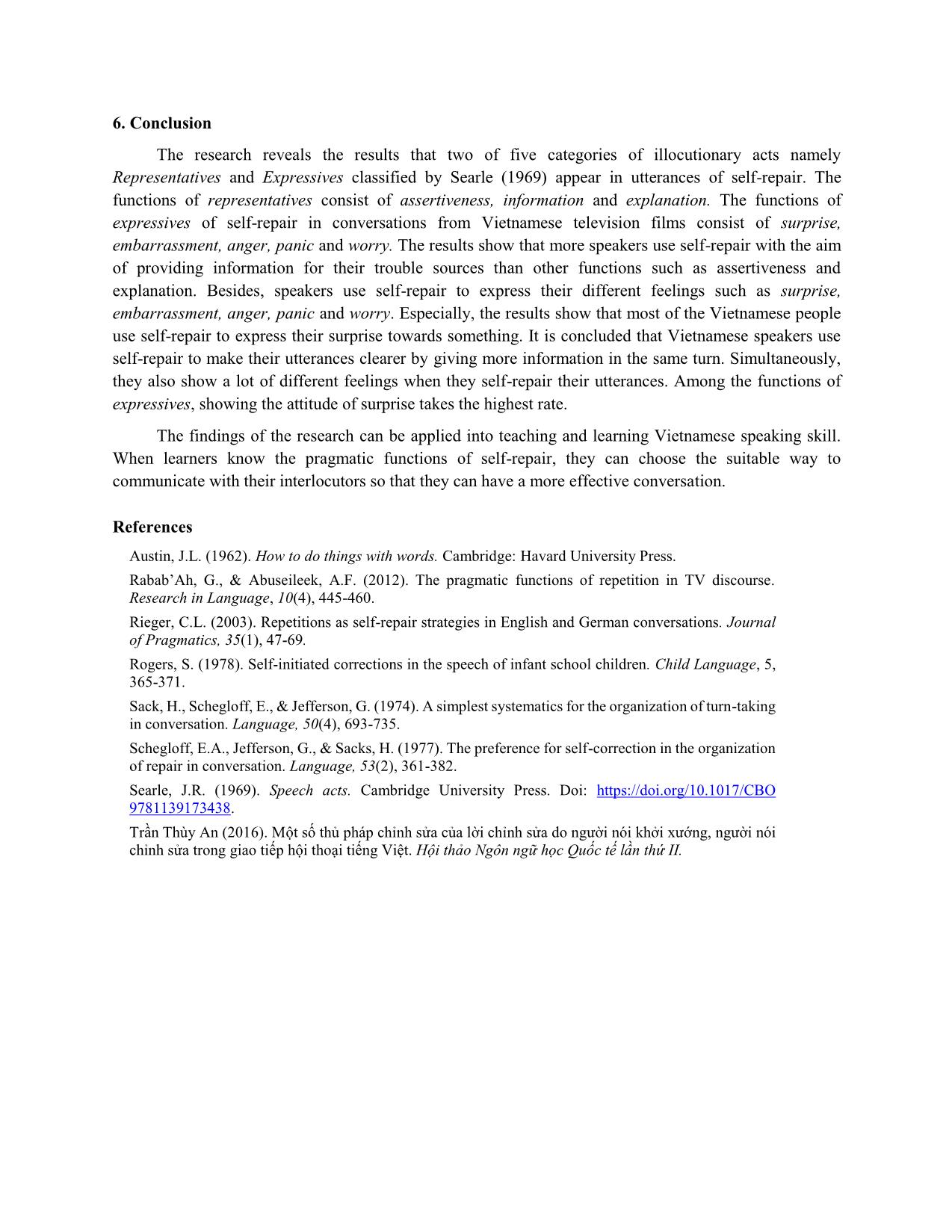
Trang 9
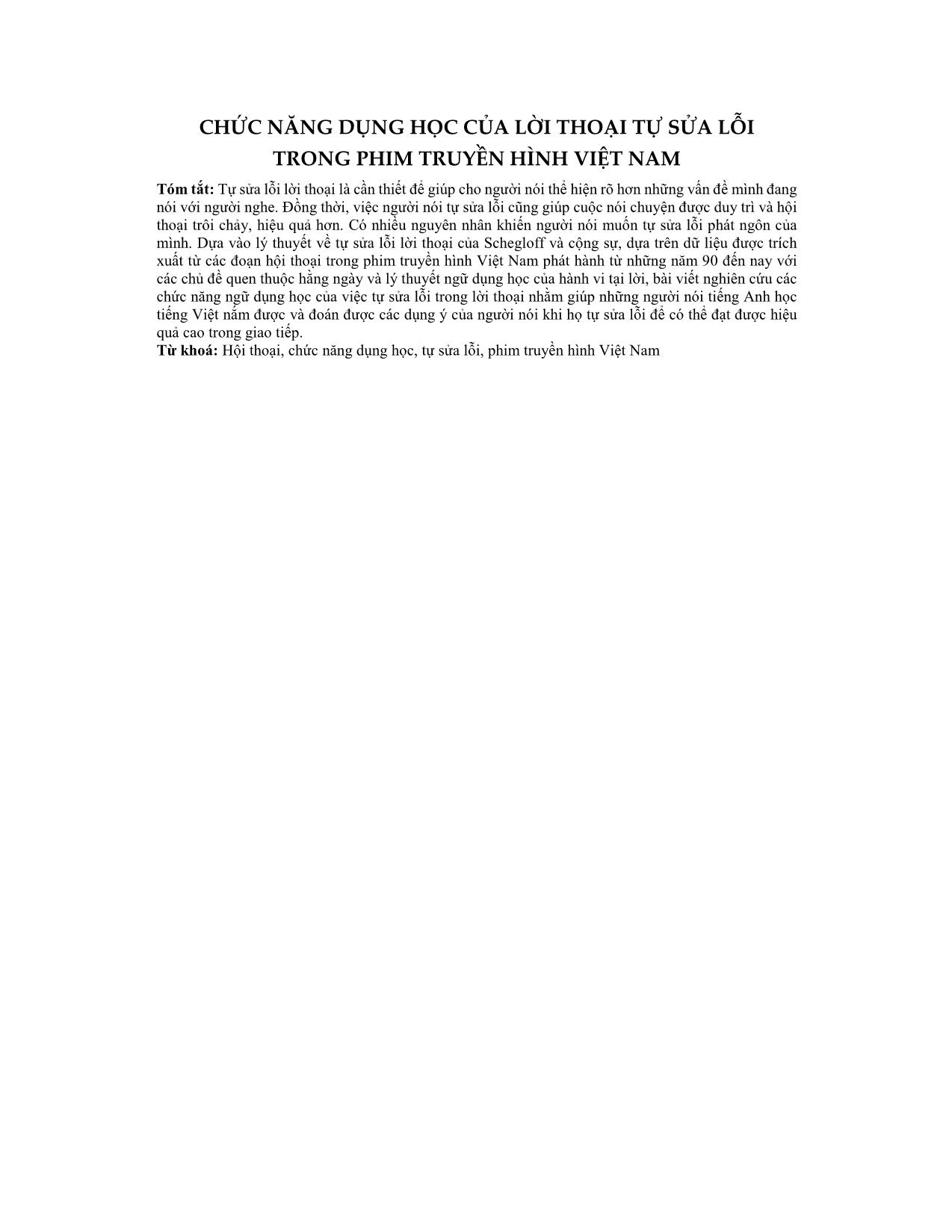
Trang 10
Tóm tắt nội dung tài liệu: Pragmatic functions of self-repair in conversations from Vietnamese television films
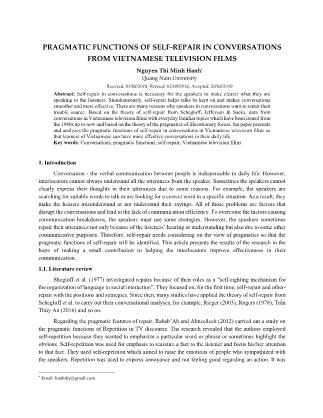
ct and Perlocutionary act; however, Searle (1969) classified illocutionary acts into five different categories such as Representatives, Directives, Commissives, Expressives and Declarations. Each category of the illocutionary acts consists of different functions. This research was carried out on the base of Searle’s theory of illocutionary act. 2.3.1. Representatives The purpose of the members of the representative class is to commit the speaker to something’s being the case. The different kinds are: suggesting, putting forward, swearing, boasting, concluding, etc. (2) S: “No one makes a better cake than me.” (Searle, 1969) In this example (2), the speaker is boasting of himself/herself. 2.3.2. Directives They try to make the addressee perform an action. The different kinds are: asking, ordering, requesting, inviting, advising, and begging. (3) S: “Could you close the window?” (Searle, 1969) In this example (3), S performs an action of requesting when S wants the hearer to close the window for her/him. 2.3.3. Commissives They commit the speaker to doing something in the future. The different kinds are: promising, planning, vowing, betting, and opposing. (4) S: “I'm going to Paris tomorrow.'' (Searle, 1969) In this example, S talks about her/his future plan. 2.3.4. Expressives They express how the speaker feels about the situation. The different kinds are: thanking, apologizing, welcoming, and deploring. (5) S: “I am sorry that I lied to you.'' (Searle, 1969) In this example (5), S feels sorry and makes an apology. 2.3.5. Declarations The purpose of the members of the declarative class is to bring into existence the state of affairs to which it refers. The different kinds are blessing, firing, baptizing, bidding, passing sentence, and excommunicating. (6) S: “You are fired, I swear, I beg you.” (Searle, 1969) This example (6) shows that the speaker makes a declaration to the hearer. 3. Methods This study adopted descriptive and analytic methods. Two criteria to select data from Vietnamese films were established: (1) the samples have to be conversational utterances that contain self-repair, (2) the samples are taken from Vietnamese films. The episodes of forty-seven films were randomly chosen. The years of the films’ release are from 1990s to 2010s; hence, the utterances in conversations are up-to-date and similar to what people say in everyday life conversations. With the above set criteria, 518 English conversations from forty-seven Vietnamese films were collected to build up the data. Such a number of conversations can be reliable enough to represent various pragmatic functions of self-repair. 4. Findings The results of investigating 518 conversations from 47 Vietnamese television films show that 2 of 5 categories of illocutionary acts classified by Searle (1969) appear in utterances of self-repair: Representatives and Expressives. These two kinds of illocutionary acts show a lot of pragmatic functions of self-repair in conversations. Their results are presented in the following sub-sections. 4.1. Representatives The data shows the functions of representatives of self-repair in conversations are assertiveness, information and explanation. 4.1.1. Assertiveness (7) S: Anh là...là anh Tú vịt...đúng rồi...anh là Tú vịt đúng không? (S: Are you...are you Mr Tu “duck”...ah...yes...Mr Tu “duck”?) (Ngày hè sôi động, Tập 3, 01:03:00) (The active summer, Episode 3, 01:03:00) In (7), S recognizes that the boy standing in front of her is her brother’s friend and he has got a nickname Tú vịt (Tu “duck”), but she is not sure because they have not met for a long time. However, the way that she recalls him Tú vịt (Tu”duck”) after her hesitation makes sure that she knows him clearly and exactly. 4.1.2. Information (8) S: Thưa Thầy, Thầy có nhớ cô gái ngày xưa hay đi với con ở trường Hàng Cót, cô gái ấy là hoa khôi của trường ta thời ấy ạ. (S: Dear Madame (the nun), do you remember the girl who used to go to Hàng Cót school in the old days, the girl who was the beauty Queen of our school at that time? H: Vâng, tôi nhớ rồi. Cô Thơ hay còn gọi là cô Lụa. (H: Yes, I do. Ms Thơ or the other name is Ms Lụa.) (Nếp nhà, tập 1, 00:04:54) (Family’s Habits, Episode 1, 00:04:54) In this setting (8), two women visit the old pagoda where they used to come when they were young. One woman asks the superior monk to try to remember the name of the other woman. Her explanation in the same turn reminds the superior monk of the woman’s name. 4.1.3. Explanation (9) S: À má, con nghĩ mình nên về quê coi mấy bác ra sao nghe má. Ý con nói là ngó qua cho biết thôi chứ con đâu có ưa mấy bác đâu. (Nước chảy xuôi dòng, 02:27:48) (S: Mum, I think we should return to our hometown to visit our uncles. I mean we only drop over them because I do not like them) (Smooth water, 02:27:48) In the above example, the mother does not want to return to her husband’s hometown because she does not like the relatives there. She left the hometown and stayed all her life with her children on the boat when her husband died. However, her daughter wants to return to the hometown and visit her uncles. She tries to explain her thoughts in the most persuasive way so that her mother can accept her suggestion. Table 1. Pragmatic functions of representatives of self-repair in Vietnamese television films Order Functions Occurrences 1 Assertiveness 13 2 Information 21 3 Explanation 19 Figure 1. Pragmatic functions of representatives of self-repair in Vietnamese television films Figure 1 shows that the functions of representatives of self-repair in conversations from Vietnamese television films consist of assertiveness, information and explanation. Of these three functions, information has the highest occurrences. 4.2. Expressives The survey shows the functions of expressives of self-repair in conversations are feelings of surprise, embarrassment, anger, panic and worry. 4.2.1. Surprise (10) S: Sao? Cậu định đằng sau quay, đào ngũ? Tớ hiểu rồi, bây giờ cậu muốn đi. (S: What? Are you going to about-turn, desert from the army? I know, you want to leave now.) (Đường lên Điện Biên, Tập 9, 00:25:11) (Ways to Dien Bien, Episode 9, 00:25:11) In this conversation (10), the captain says to the young soldier in his battalion. The captain feels surprised by the soldier’s negative attitude because this soldier has always been active and optimistic. Self-repairing his utterance by using the word đào ngũ not only helps the soldier understand what he is saying clearly but also shows the captain’s surprising attitude to the active soldier. 4.2.2. Embarrassment (11) S: Cháu muốn, cháu muốn mượn lương của cô tháng nay được không ạ? (S: I want, Could I borrow your salary this month, please?) (Ngày hè sôi động, Tập 4, 00:16:32) (The active summer, Episode 4, 01:03:00) In this setting, the girl repairs her utterance by expressing her wish to borrow money from her aunt; however, her self-repair shows her embarrassment in her saying. She knows that her aunt is not rich and her borrowing may cause some difficulties for her aunt. 4.2.3. Anger (12) S: Cậu phải như tôi đây này, có ai động vào đâu. Ý tôi nói là mình phải khéo léo, nhẫn nhịn. (S: You must behave as the same way as I do so that no one dare say anything. I mean you must be clever and patient) (Khi đàn chim trở về, tập 36, phần 3, 00:41:06) (When the birds return, Episode 36, Part 3, 00:41:06) In (12), this is the conversation between the manager and the employee. The manager repairs his utterance for his employee to understand his meaning, but he also wants to show his anger because the employee has not got his advice before. 4.2.4. Panic (13) S: Cái gì? Con cá sấu chúa, vợ em tới công ty hả? (S: What? Is the Queen crocodile, my wife coming to the company?) (Thuê chồng, 00:43:02) (Husbands for rent, 00:43:02) In this conversation, when one of three men who work for a company named “Husband for rent” hears the nickname “cá sấu chúa” (the Queen crocodile), he repairs his utterance in his turn by explaining that cá sấu chúa (the Queen crocodile) is his wife. His explanation also shows that he feels so panic when his wife is coming to the company. 4.2.5. Worry (14) S: Cô ơi, cô làm ơn cho tôi hỏi con trai tôi chờ ở đâu ạ? Hành khách chuyến bay hoãn sẽ chờ ở đâu ạ? (S: Excuse me, madame, do you know where my son is waiting? Where will passengers whose flights are delayed wait? (Tết không chỉ có hoa đào, tập 6, 46:30) (Tet not only has peach blossom, Episode 6, 46:30) In this film, the father always thinks that the boy is not his son. After many years of studying and living abroad, the son returns home, but the father always keeps his distance from him. When knowing that his father needs to transplant the liver, the son is willing to do that. Being refused from the father, the son decides to go abroad again. However, the farther goes to the airport and tries to find his son. He feels so worried because the flight nearly departs. When he asks “Cô làm ơn cho tôi hỏi con trai tôi chờ ở đâu ạ”, he recognizes his trouble source and starts repair in the same turn. His worry is expressed via his ways of saying and repairing. Table 2. Pragmatic functions of expressives of self-repair in Vietnamese television films Order Functions Occurrences 1 Surprise 21 2 Embarrassament 7 3 Anger 6 4 Panic 3 5 Worry 5 Figure 2. Pragmatic functions of expressives of self-repair in Vietnamese television films Figure 2 shows that the functions of expressives of self-repair in conversations from Vietnamese television films consist of surprise, embarrassment, anger, panic and worry. Of these five functions, surprise has the highest occurrences. 5. Discussion and implications The results show that the categories of illocutionary acts classified by Searle (1969) such as representatives and expressives appear in self-repair in conversations from Vietnamese television films. The functions of representatives consist of assertiveness, information and explanation. Of these three functions, information has the highest occurrences. Learners of Vietnamese need to pay attention to the functions of representatives so that they can overcome the possible breakdowns during their conversations. Especially, learners should give clear utterances which contain enough information for the listeners. Beside that, the functions of expressives of self-repair in conversations from Vietnamese television films consist of surprise, embarrassment, anger, panic and worry. Of these five functions, surprise has the highest occurrences. These results help learners of Vietnamese know that speakers can use self-repair with a lot of pragmatic functions. The best way for learners to understand the interlocutors’ underlying meanings is that they should observe the attitudes of the speakers during their conversations. When the interlocutors know how to self-repair to correct their trouble sources and know how to use self-repair to convey their feelings, they will gain effective conversations. 6. Conclusion The research reveals the results that two of five categories of illocutionary acts namely Representatives and Expressives classified by Searle (1969) appear in utterances of self-repair. The functions of representatives consist of assertiveness, information and explanation. The functions of expressives of self-repair in conversations from Vietnamese television films consist of surprise, embarrassment, anger, panic and worry. The results show that more speakers use self-repair with the aim of providing information for their trouble sources than other functions such as assertiveness and explanation. Besides, speakers use self-repair to express their different feelings such as surprise, embarrassment, anger, panic and worry. Especially, the results show that most of the Vietnamese people use self-repair to express their surprise towards something. It is concluded that Vietnamese speakers use self-repair to make their utterances clearer by giving more information in the same turn. Simultaneously, they also show a lot of different feelings when they self-repair their utterances. Among the functions of expressives, showing the attitude of surprise takes the highest rate. The findings of the research can be applied into teaching and learning Vietnamese speaking skill. When learners know the pragmatic functions of self-repair, they can choose the suitable way to communicate with their interlocutors so that they can have a more effective conversation. References Austin, J.L. (1962). How to do things with words. Cambridge: Havard University Press. Rabab’Ah, G., & Abuseileek, A.F. (2012). The pragmatic functions of repetition in TV discourse. Research in Language, 10(4), 445-460. Rieger, C.L. (2003). Repetitions as self-repair strategies in English and German conversations. Journal of Pragmatics, 35(1), 47-69. Rogers, S. (1978). Self-initiated corrections in the speech of infant school children. Child Language, 5, 365-371. Sack, H., Schegloff, E., & Jefferson, G. (1974). A simplest systematics for the organization of turn-taking in conversation. Language, 50(4), 693-735. Schegloff, E.A., Jefferson, G., & Sacks, H. (1977). The preference for self-correction in the organization of repair in conversation. Language, 53(2), 361-382. Searle, J.R. (1969). Speech acts. Cambridge University Press. Doi: https://doi.org/10.1017/CBO 9781139173438. Trần Thùy An (2016). Một số thủ pháp chỉnh sửa của lời chỉnh sửa do người nói khởi xướng, người nói chỉnh sửa trong giao tiếp hội thoại tiếng Việt. Hội thảo Ngôn ngữ học Quốc tế lần thứ II. CHỨC NĂNG DỤNG HỌC CỦA LỜI THOẠI TỰ SỬA LỖI TRONG PHIM TRUYỀN HÌNH VIỆT NAM Tóm tắt: Tự sửa lỗi lời thoại là cần thiết để giúp cho người nói thể hiện rõ hơn những vấn đề mình đang nói với người nghe. Đồng thời, việc người nói tự sửa lỗi cũng giúp cuộc nói chuyện được duy trì và hội thoại trôi chảy, hiệu quả hơn. Có nhiều nguyên nhân khiến người nói muốn tự sửa lỗi phát ngôn của mình. Dựa vào lý thuyết về tự sửa lỗi lời thoại của Schegloff và cộng sự, dựa trên dữ liệu được trích xuất từ các đoạn hội thoại trong phim truyền hình Việt Nam phát hành từ những năm 90 đến nay với các chủ đề quen thuộc hằng ngày và lý thuyết ngữ dụng học của hành vi tại lời, bài viết nghiên cứu các chức năng ngữ dụng học của việc tự sửa lỗi trong lời thoại nhằm giúp những người nói tiếng Anh học tiếng Việt nắm được và đoán được các dụng ý của người nói khi họ tự sửa lỗi để có thể đạt được hiệu quả cao trong giao tiếp. Từ khoá: Hội thoại, chức năng dụng học, tự sửa lỗi, phim truyền hình Việt Nam
File đính kèm:
 pragmatic_functions_of_self_repair_in_conversations_from_vie.pdf
pragmatic_functions_of_self_repair_in_conversations_from_vie.pdf

